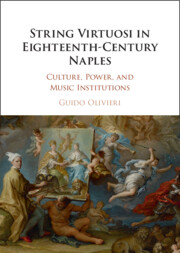Book contents
- String Virtuosi in Eighteenth-Century Naples
- String Virtuosi in Eighteenth-Century Naples
- Copyright page
- Dedication
- Contents
- Figures
- Tables
- Music Examples
- Acknowledgments
- Introduction
- 1 Music Institutions in Naples
- 2 The Formation of the Neapolitan String Virtuosi
- 3 Cello Virtuosi
- 4 Between Naples and Paris
- 5 Neapolitan Virtuosi in the Public Sphere
- 6 Neapolitan Instrumental Music under the Austrian Domination
- 7 Under the Wings of the Imperial Eagle
- Epilogue
- Bibliography
- Index
5 - Neapolitan Virtuosi in the Public Sphere
The “Tastes Reunited”
Published online by Cambridge University Press: 13 January 2024
- String Virtuosi in Eighteenth-Century Naples
- String Virtuosi in Eighteenth-Century Naples
- Copyright page
- Dedication
- Contents
- Figures
- Tables
- Music Examples
- Acknowledgments
- Introduction
- 1 Music Institutions in Naples
- 2 The Formation of the Neapolitan String Virtuosi
- 3 Cello Virtuosi
- 4 Between Naples and Paris
- 5 Neapolitan Virtuosi in the Public Sphere
- 6 Neapolitan Instrumental Music under the Austrian Domination
- 7 Under the Wings of the Imperial Eagle
- Epilogue
- Bibliography
- Index
Summary
The Neapolitan string virtuosi who moved to Paris were among the protagonists of the early private and public concert series. The editorial success of Michele Mascitti – nephew and student of Pietro Marchitelli – is paradigmatic of the growing influence of the “public sphere”: revenues from his nine collections of sonatas allowed Mascitti to live for many years as a freelance musician while having a crucial part in the formation of a modern public. Together with Mascitti, Giovanni Antonio Guido, a student of Cailò in Naples, participated to the weekly soirées organized at the residence of the Crozat brothers in Paris. Guido’s presence at these splendid gatherings of the finest intellectuals and artists is attested by his portrait sketched by Antoine Watteau, also a protegé of the Crozat family, during one of these events. The aesthetic approach and performance practice imported in France by the Neapolitan string virtuosi became à la mode in the 1720s. The mixture of the Italian virtuosic approach with the French instrumental tradition that is found in the later sonatas by Mascitti and Guido was typical of the so-called goûts réunis, the “reunited tastes” of French and Italian music that would end up dominating the European scene in the second quarter of the eighteenth century.
Keywords
- Type
- Chapter
- Information
- String Virtuosi in Eighteenth-Century NaplesCulture, Power, and Music Institutions, pp. 146 - 184Publisher: Cambridge University PressPrint publication year: 2023



